Elevator pitch
South Korea has boasted one of the world's most successful economies since the end of World War II. The South Korean labor market has recovered quickly from the depths of the Asian crisis in 1998, and has since remained surprisingly sound and stable. The unemployment rate has remained relatively low, and average real earnings have steadily increased. The South Korean labor market was resilient in the wake of the global financial crisis. However, there are issues that require attention, including high earnings inequality, an aging labor force, increasing part-time jobs, and rising youth unemployment rates.
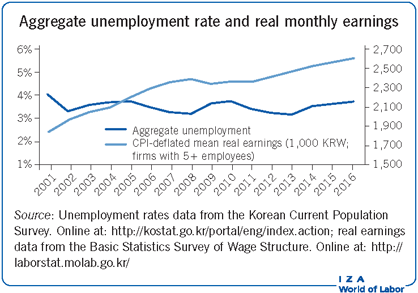
Key findings
Pros
Unemployment has been low and stable, even during the global financial crisis.
Labor force participation for both men and women has been quite steady, and there is no significant gender difference in unemployment.
Average worker real earnings have risen since the immediate recovery from the 1998 Asian crisis.
South Korea is one of the OECD countries with the longest working hours, but weekly working hours have fallen considerably in recent years.
The gender gap in educational achievement has closed, and the share of college-educated workers is high.
Cons
Youth unemployment is increasing and much higher than the adult average.
The female labor force participation rate is far lower than for men, and the gap is closing very slowly; the gender earnings gap is also large.
The share of part-time workers has increased and is higher in small-sized establishments.
Earnings inequality has increased in the lower part of the earnings distribution, due in large part to the decrease in relative earnings of small firm workers.
The share of part-time workers has increased and is higher in small-sized establishments.
The labor force is getting older; labor shortage and skill mismatch are potential problems in the future.
Author's main message
Overall, the South Korean labor market looks healthy. Unemployment has remained below 4% since 2002 and average real monthly earnings have increased considerably, with only a small dip during the global financial crisis. However, the South Korean labor market is facing difficulties related to youth unemployment, weak female labor force participation, rising earnings inequality, and a rapidly aging labor force. Policymakers should consider steps to strengthen tax progressivity and the social safety net, develop labor market programs to promote fertility and female labor force participation, and encourage long-term investment in education.
Motivation
South Korea is a small country with a large economy, ranked 110th globally in area size but 11th in terms of nominal GDP in 2016. Following its successful economic development after the Korean War, South Korea is considered a role model by many developing countries. Quickly recovering from the 1998 Asian crisis, its labor market has been sound and stable. Unemployment has remained low, and real earnings have increased steadily. However, the labor market is facing several challenges. Some of the most pressing problems are not easy to resolve because they stem from long-term structural changes of the economy.
Discussion of pros and cons
Unemployment rates: Aggregate, by gender and age
The South Korean labor market recovered quickly from the Asian crisis in 1998. Figure 1 shows the long-term trend of the aggregate unemployment rate from 1990 through 2016 (based on the Korean Current Population Survey (K-CPS) annual data). The unemployment rate jumped to 7% in 1998, 4.4 percentage points higher than the year prior to the crisis. But it dropped to 6.3% one year later and then down to 4.4% in 2000. Since 2001, the annual unemployment rate has remained low, hovering at around 3.5% of the labor force. Even though the South Korean economy is internationally open in terms of both product and financial markets, there was virtually no real impact of the global financial crisis on the labor market—the unemployment rate was slightly higher in 2009 and 2010, but the changes were insignificant [1].
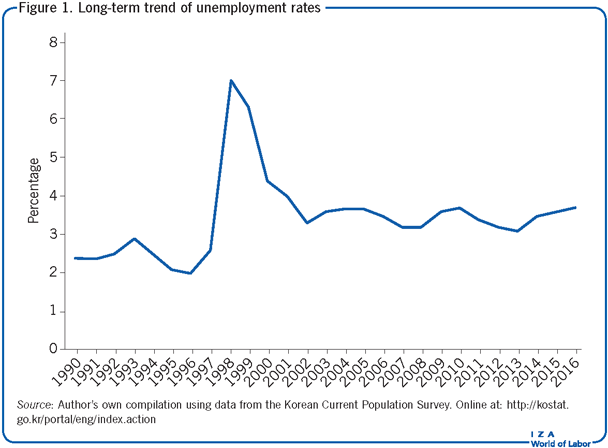
One notable finding in Figure 1 is that there seems to have been a structural change in the long-term equilibrium unemployment rate in the South Korean labor market after the 1998 crisis. The average unemployment rate was about 2.4% from 1990 to 1997. The average rate after the crisis has been consistently higher by about one percentage point throughout the period of 2001–2016. The reasons behind this fundamental change have not yet been discovered conclusively. A study from 2015 estimates the natural rate of unemployment and finds that both the job-finding rate and the job-separation rate increased after the Asian crisis [2]. It argues that these changes were driven by an increase in labor market flexibility, which was strongly recommended by the IMF.
Figure 2 shows unemployment rates disaggregated by gender and age. Regarding gender, men's aggregate unemployment rates (for those aged 15 and older) are higher than women's throughout the period from 2000 to 2016. However, this gender gap has shrunk in the last three years, and there is now no significant difference between genders. The gap is much larger and persistent among youth aged 15 to 29 though, averaging out to around 2.6 percentage points over the period.
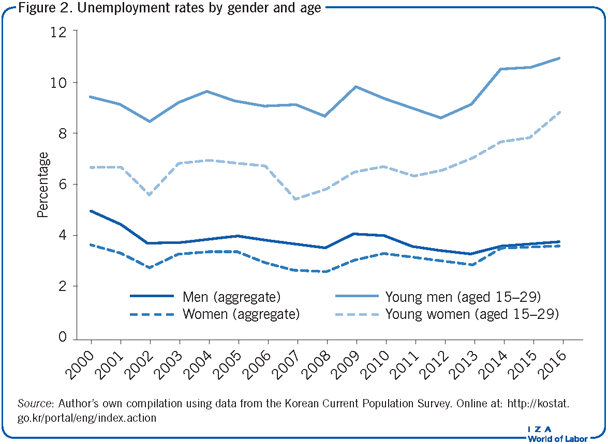
Figure 2 also shows why there is concern about rising youth unemployment in South Korea. The aggregate youth unemployment rate reached 9.8% in 2016; still lower than the 12.2% seen during the 1998 crisis, and much lower than in most EU countries, where high youth unemployment rates have become a chronic social problem. Even so, this is still clearly worrisome given that it is far above the adult rates and because there has been an upward trend since 2012. The recent increase in youth unemployment has been driven by several factors on both the demand and supply sides. Among these, recent changes in the college matriculation rate (the percentage of individuals who enter college) are noteworthy. In South Korea this rate has been very high, which has created concerns about over-education and skill mismatch in the labor market. The matriculation rate was 68% in 2000 and increased to 84% in 2008, South Korea's historical peak. It started dropping after this peak and has been lower than 71% since 2013. The simultaneous increase in the inflows into the labor market of both high school graduates from recent cohorts with lower matriculation rates and college graduates from earlier cohorts with high college matriculation rates should make the market for new labor market entrants more competitive. This would thus increase the youth unemployment rate, at least temporarily, unless the demand for labor increases sufficiently.
Labor force participation: Aggregate, by gender and age
The trends of labor force participation rates disaggregated by gender and age since 2000 are shown in Figure 3. Each of the trends shown is essentially flat. Total labor force participation rates have averaged 61.7%, with only very minor changes in the past 17 years. The lowest rate was 60.8% in 2009, while the highest was the 2016 rate of 62.8%. Disaggregated by gender, men's participation rate has averaged about 74%, with a slightly decreasing trend until 2009 and an upward trend thereafter. Women's participation rate has been about 25 percentage points lower than men’s. Overall, women's labor force participation rate is increasing, rising from 48.8% in 2000 to 52.1% in 2016. However, this increase is not large and the gender gap is closing, albeit very slowly. According to OECD statistics, female labor force participation in South Korea is much lower than in Japan (68.1%), in the US (67.3 %), and the OECD average (63.6%). This is surprising, particularly given the country's very low fertility rate (the total fertility rate in 2015 was only 1.24, which is below the natural replacement rate) and high female education levels (women's college matriculation rate has exceeded men's since 2009). The proportion of females among professional occupations, such as medical doctors, lawyers, and managers, has increased substantially, but there has been no significant progress in the labor force participation of women overall.
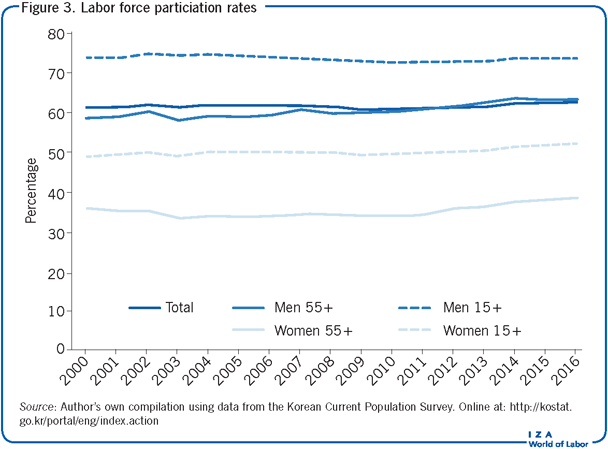
The labor force participation rate for older workers (55 years and older) for the period from 2000 to 2016 was 46.3%, which is 15.4 percentage points lower than the population average. The rate for older men averaged 60.6% and older women 34.8%. This phenomenon is partly due to South Korea's weak social insurance system for the elderly and partly due to low fertility rates. The poverty rate for persons aged 66 or older is the highest among OECD countries, at 45.7% in 2015 (the comparable US figure is 20.9%).
Earnings inequality
Like many other countries, rising earnings inequality is now receiving more attention as a social problem in South Korea. To look at earnings inequality, data from the Basic Statistics Survey of Wage Structure (BSWS) is used, which collects information on earnings and working hours directly from payroll records (earnings of the K-CPS are self-reported by household surveys and thus plagued by measurement errors). The time span of the available BSWS data differs by establishment size; the data are available since 1968 for establishments with ten employees or more (BSWS 10+), since 1999 for those with five employees or more (BSWS 5+), and finally since 2006 for all establishments with at least one employee (the data including all-sized firms are now referred to as the Survey on Labor Conditions by Employment Type (SLCET)). Figure 4 shows two inequality measures—90/50 and 50/10 ratios, which compare the ninth decile to median earnings, and median earnings to the first decile, respectively— from all three data sets.
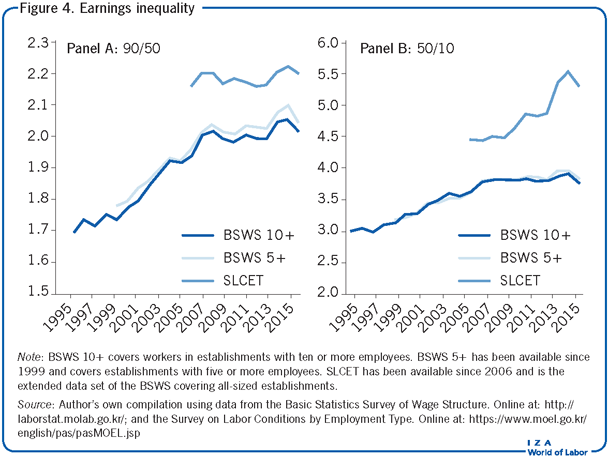
Panel A shows the 90/50 trends. These trends are similar across all data sources; increasing until the mid-2000s and stabilizing thereafter. In other words, earnings inequality in the upper part of the earnings distribution has neither improved nor worsened since the mid-2000s. When examining the SLCET data, which include small-sized establishments, the ratio becomes higher but the trend is similar.
Panel B shows the 50/10 trends. For workers employed in establishments with five or more employees, the 50/10 gap stopped increasing in the late-2000s, and even started decreasing slightly since 2010. However, when including workers in small-sized establishments with one to five employees (SLCET data), the picture is very different. The gap is not only much larger, but it has also increased since the late-2000s, with only a small drop in 2016. This means that inequality has risen in the lower part of the earnings distribution during the last decade, and the increase has been driven by employees in small-sized establishments.
Figure 5 shows trends in earnings gaps by gender and education. Panel A shows female– male earnings ratios (i.e. female average earnings divided by male average earnings). The three series from the three data sets are similar in trends, but vary in levels; the gender earnings gap is larger among those working in small-sized establishments (SLCET data). Looking at the long-term trend, female earnings have moved closer to male earnings, with some setbacks in 2014 and 2015. Despite this gradual convergence, the gender earnings gap in South Korea is large, and has never been below 30%.
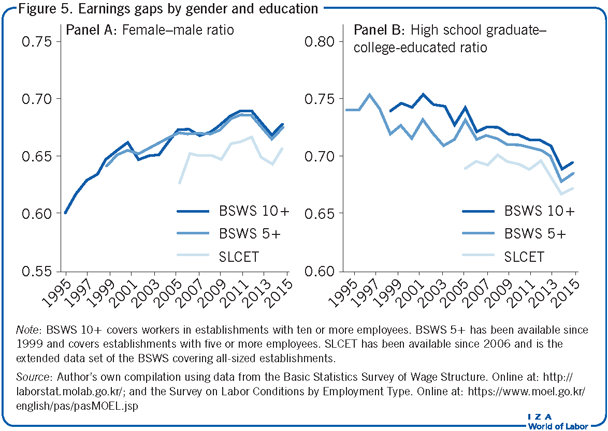
Panel B shows the ratio of high school graduate workers’ mean earnings to those of college-educated workers, which are the two largest education groups in the South Korean workforce. The data clearly show that the earnings gap by education has increased consistently since 1995. Given the rapid increase in the college matriculation rate and the associated rise in the supply of college-educated workers, this group's relative earnings growth has likely been driven by larger increases in the relative demand for college-educated workers compared to those with only a high school education.
Hours of work
It is well known that South Koreans work very long hours. According to OECD statistics, South Korea's 2015 average annual working hours were 2,082 hours, ranking as the second highest number globally after Mexico. Figure 6 shows Korea's average weekly working hours. Regardless of data sources, the overall trend is decreasing with some regular ups and downs along the business cycle. Based on statistics from BSWS 5+, total weekly working hours including overtime were 53.4 hours in 1999, and have since dropped to 45.5 hours in 2016. Regular hours decreased by 5.4 hours and overtime hours decreased by 1.9 hours. These decreases in regular hours are more noticeable since 2004, as they have been driven by the legislated cut of weekly standard hours from 44 to 40 hours, which was implemented gradually by industry and establishment size (starting with the public and financial sectors, and larger establishments) [3]. There are little gender differences in terms of regular hours. However, men tend to work more overtime than women. Thus, men's total weekly hours are on average 2.4 hours longer than women’s.
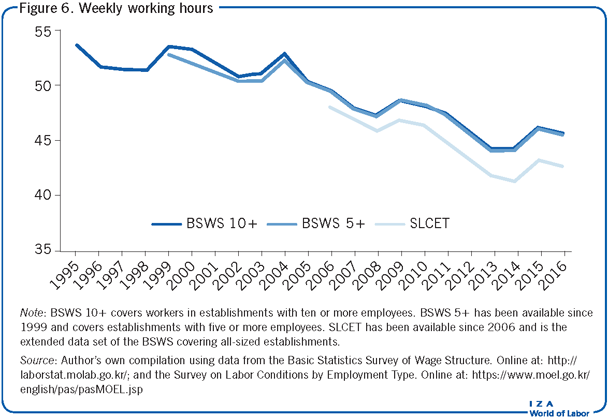
One recent notable phenomenon in terms of working hours is the increase in part-time work, as shown in Figure 7. Using data from BSWS 5+, the percentage of people working fewer than 35 hours per week (the South Korean definition of part-time worker) was only 1.5% of the entire workforce in the early 2000s, but has increased more than threefold to reach 5% in 2016. The rise of part-time jobs provides more flexibility in the labor market, but, at the same time, is worrisome because it indicates a deterioration of job quality.
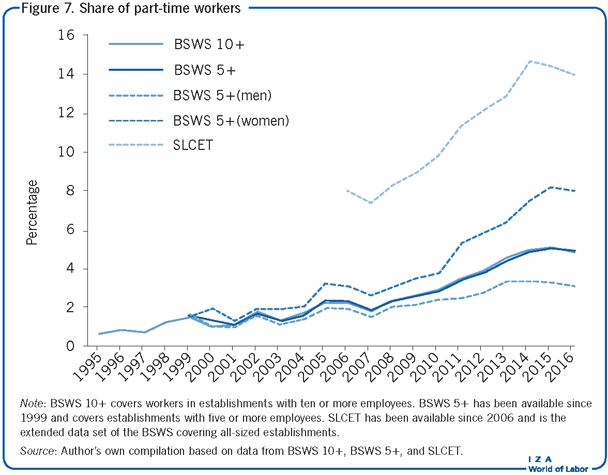
Though the increase in part-time work is observed for both men and women, it is mainly driven by women. There was little difference between genders in the early 2000s, but by 2016 the percentage of part-time workers had increased to about 8% for women, while it remained around 3% for men. Unsurprisingly, there are many more part-time workers in small-sized establishments. Using SLCET data, part-time workers accounted for about 14% of the workforce in 2016. The percentage of part-time workers among youth aged 15–29 (not shown in Figure 7) has also increased between 1999 and 2016, from 1% to 5%, but no gender difference is observed for this group.
Changing composition of the labor force
In the past two decades, the most salient changes in the composition of the South Korean workforce have been the increases in the mean age and educational level of workers. South Korea is not only a country with low fertility, but also the fastest aging country in the world. As seen in Figure 8, the mean age of workers has been increasing rapidly, from 36 in 1999 to nearly 42 in 2016. This means the labor force has gotten older by an average of 0.3 years every year. This trend is driven by demographic changes including decreasing fertility rates and increasing longevity. As a result, the mean job tenure has increased as well, from 5.6 years in 2000 to 6.2 in 2015. In terms of gender, the male labor force is older than the female labor force. This difference is partly due to later labor market entry of men resulting from male-only mandatory military service, which lasts between 21 and 24 months depending on the branch of the military. However, the gender gap in age has shrunk over the years, from 5.5 years in 1999 to 2.3 years in 2016. This aging labor force is challenging the South Korean labor market because the size of younger cohorts entering the labor market has gotten smaller. While an increasing youth unemployment rate is a concern at present, there is a simultaneous worry about future labor shortages.
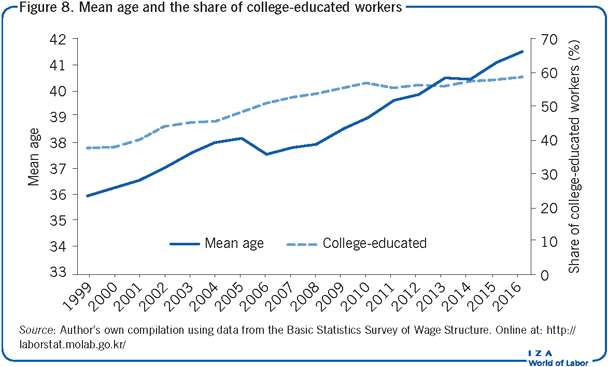
Another significant trend in the South Korean labor market during the past two decades is the increasing share of highly-educated workers. The share of college-educated workers has grown from 37% in 1999 to 58% in 2016. This increasing trend has slowed down since 2010, as the college matriculation rate stopped increasing in 2008. The large share of college-educated workers, together with increasing youth unemployment, has created social concerns about skill mismatch and long-term unemployment. Ultimately, whether these highly-educated workers are “over-educated,” meaning that their skills are underutilized, depends on the macroeconomic prospects regarding economic growth, employment creation, and the quality of jobs the economy will create.
Limitations and gaps
There are two major caveats to the description of the South Korean labor market presented in this article. First, although the data sources used here do not exclude foreign immigrant workers, it is doubtful how well the surveys represent them. The official statistics say that they account for about 10% of the labor force in 2015, and there may be more who are working illegally.
The second significant caveat concerns the self-employed. The share of self-employed workers is relatively high in South Korea, accounting for 21% of the labor force. While labor market data on the self-employed are available, their earnings (business income) are not directly comparable to those for employees (wages and salaries). They are also subject to different tax schedules and social welfare programs.
Summary and policy advice
On the whole, the South Korean labor market has performed markedly well over the past two decades. It recovered quickly from the 1998 Asian crisis, and was largely unaffected by the recent global financial crisis. Unemployment has remained low and stable, and real earnings have increased. The labor force is aging rapidly, but it is also highly-educated. However, there are several concerns that must be considered as policymakers look toward the future of South Korea's labor market.
First, earnings inequality in the upper part of the earnings distribution rose rapidly until the mid-2000s, and since then inequality in the lower part has worsened. Policymakers should consider strengthening the progressivity of the tax system and social safety net programs to alleviate this growing inequality.
Second, poverty among the elderly is also a significant social problem in this rapidly aging country. Given that the labor force participation of the elderly is high, employment-friendly social welfare programs for this demographic group are necessary, at least until the national pension system becomes fully effective. This pension system was partially introduced in 1988, but it did not cover all citizens until 1999. The relative newness of this system means there are still a significant number of citizens who have not contributed enough to their pensions.
Third, the co-existence of low fertility and low female labor force participation is puzzling. However, it is clear that the solution should be found in the labor market, given the failure of population policies during the past decade.
Finally, human capital is South Korea's most important asset. In a long-term policy perspective, investment in education and technological innovation through R&D investment should be promoted.
Acknowledgments
The author thanks an anonymous referee and the IZA World of Labor editors for many helpful suggestions on earlier drafts. The author thanks Geumbi Park for her excellent assistance.
Competing interests
The IZA World of Labor project is committed to the IZA Guiding Principles of Research Integrity. The author declares to have observed these principles.
© Jungmin Lee